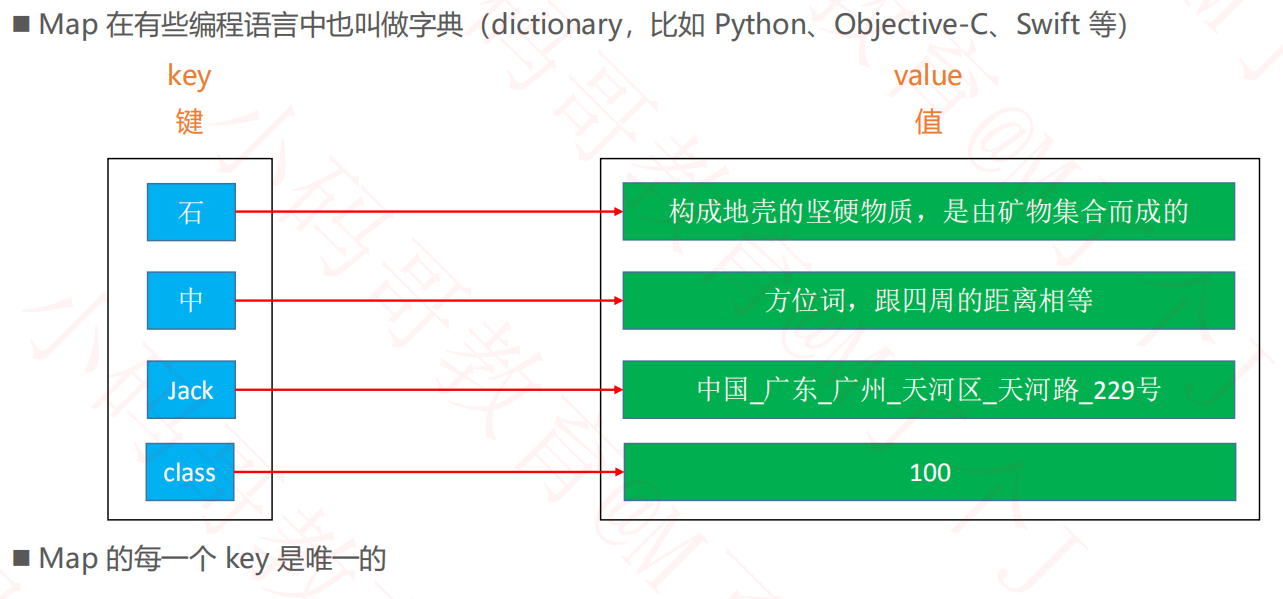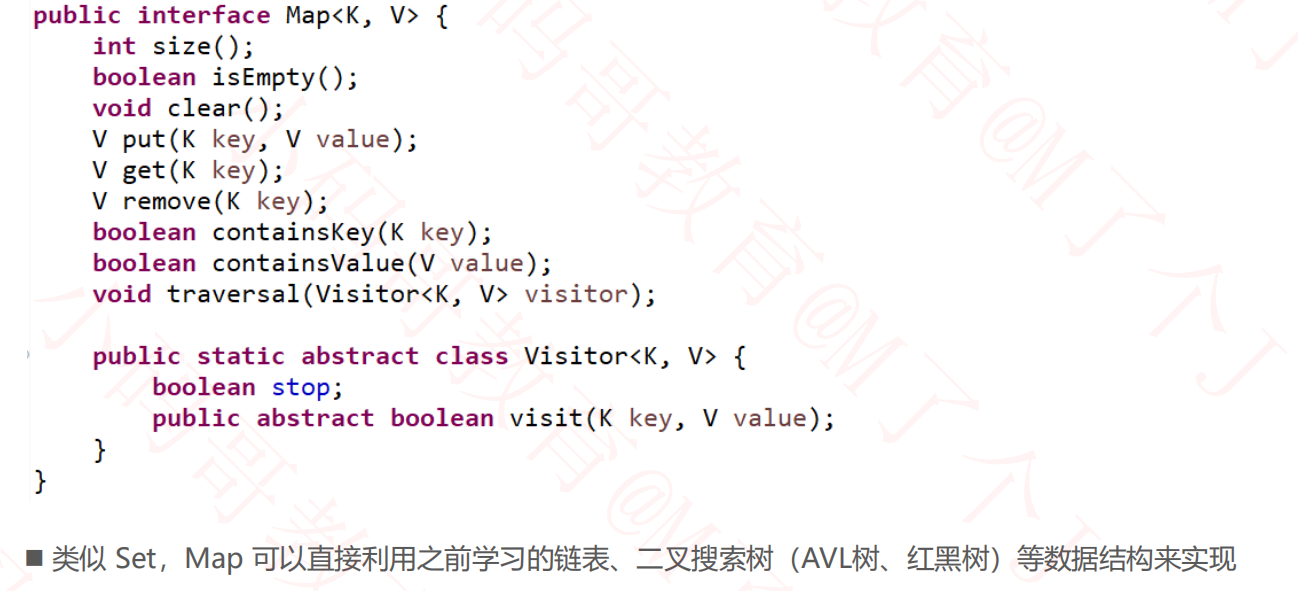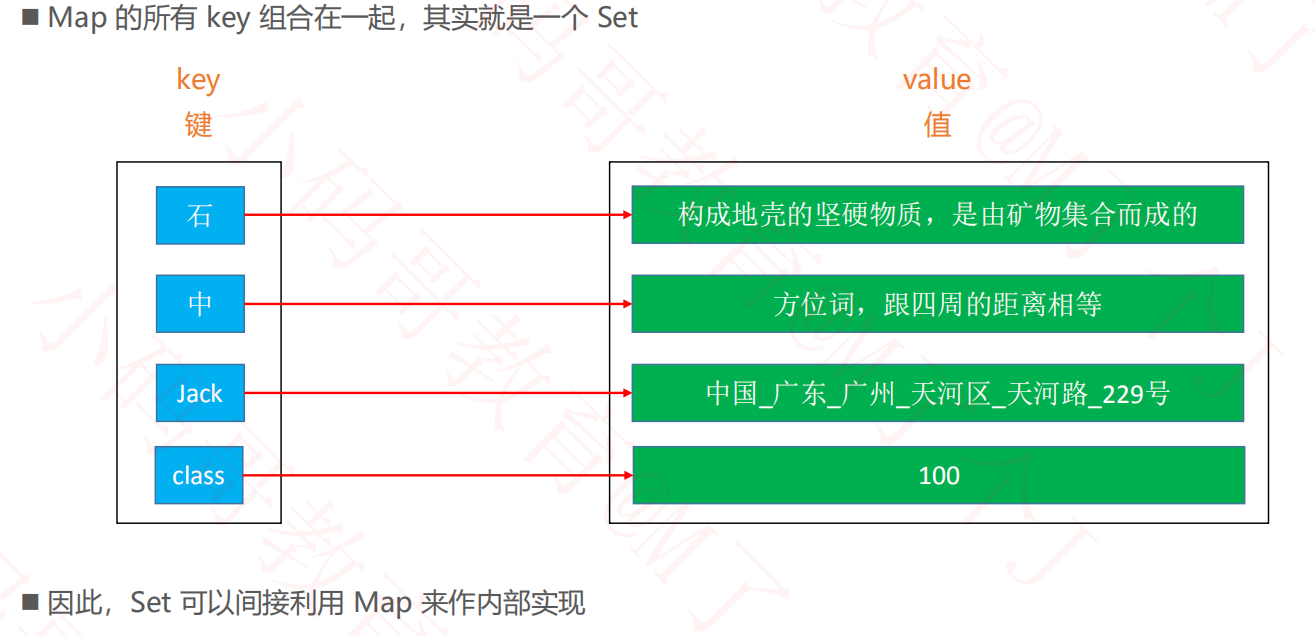1.映射
1.1基本概念

1.2接口设计

1.3Map与Set区别

2.相关代码
Map

public interface Map<K, V> { int size(); boolean isEmpty(); void clear(); V put(K key, V value); V get(K key); V remove(K key); boolean containsKey(K key); boolean containsValue(V value); void traversal(Visitor<K, V> visitor); public static abstract class Visitor<K, V> { boolean stop; public abstract boolean visit(K key, V value); } }
TreeMap

import java.util.Comparator; import java.util.LinkedList; import java.util.Queue; @SuppressWarnings({"unchecked", "unused"}) public class TreeMap<K, V> implements Map<K, V> { private static final boolean RED = false; private static final boolean BLACK = true; private int size; private Node<K, V> root; private Comparator<K> comparator; public TreeMap() { this(null); } public TreeMap(Comparator<K> comparator) { this.comparator = comparator; } public int size() { return size; } public boolean isEmpty() { return size == 0; } public void clear() { root = null; size = 0; } @Override public V put(K key, V value) { keyNotNullCheck(key); // 添加第一个节点 if (root == null) { root = new Node<>(key, value, null); size++; // 新添加节点之后的处理 afterPut(root); return null; } // 添加的不是第一个节点 // 找到父节点 Node<K, V> parent = root; Node<K, V> node = root; int cmp = 0; do { cmp = compare(key, node.key); parent = node; if (cmp > 0) { node = node.right; } else if (cmp < 0) { node = node.left; } else { // 相等 node.key = key; V oldValue = node.value; node.value = value; return oldValue; } } while (node != null); // 看看插入到父节点的哪个位置 Node<K, V> newNode = new Node<>(key, value, parent); if (cmp > 0) { parent.right = newNode; } else { parent.left = newNode; } size++; // 新添加节点之后的处理 afterPut(newNode); return null; } @Override public V get(K key) { Node<K, V> node = node(key); return node != null ? node.value : null; } @Override public V remove(K key) { return remove(node(key)); } @Override public boolean containsKey(K key) { return node(key) != null; } @Override public boolean containsValue(V value) { if (root == null) return false; Queue<Node<K, V>> queue = new LinkedList<>(); queue.offer(root); while (!queue.isEmpty()) { Node<K, V> node = queue.poll(); if (valEquals(value, node.value)) return true; if (node.left != null) { queue.offer(node.left); } if (node.right != null) { queue.offer(node.right); } } return false; } @Override public void traversal(Visitor<K, V> visitor) { if (visitor == null) return; traversal(root, visitor); } private void traversal(Node<K, V> node, Visitor<K, V> visitor) { if (node == null || visitor.stop) return; traversal(node.left, visitor); if (visitor.stop) return; visitor.visit(node.key, node.value); traversal(node.right, visitor); } private boolean valEquals(V v1, V v2) { return v1 == null ? v2 == null : v1.equals(v2); } private V remove(Node<K, V> node) { if (node == null) return null; size--; V oldValue = node.value; if (node.hasTwoChildren()) { // 度为2的节点 // 找到后继节点 Node<K, V> s = successor(node); // 用后继节点的值覆盖度为2的节点的值 node.key = s.key; node.value = s.value; // 删除后继节点 node = s; } // 删除node节点(node的度必然是1或者0) Node<K, V> replacement = node.left != null ? node.left : node.right; if (replacement != null) { // node是度为1的节点 // 更改parent replacement.parent = node.parent; // 更改parent的left、right的指向 if (node.parent == null) { // node是度为1的节点并且是根节点 root = replacement; } else if (node == node.parent.left) { node.parent.left = replacement; } else { // node == node.parent.right node.parent.right = replacement; } // 删除节点之后的处理 afterRemove(replacement); } else if (node.parent == null) { // node是叶子节点并且是根节点 root = null; } else { // node是叶子节点,但不是根节点 if (node == node.parent.left) { node.parent.left = null; } else { // node == node.parent.right node.parent.right = null; } // 删除节点之后的处理 afterRemove(node); } return oldValue; } private void afterRemove(Node<K, V> node) { // 如果删除的节点是红色 // 或者 用以取代删除节点的子节点是红色 if (isRed(node)) { black(node); return; } Node<K, V> parent = node.parent; if (parent == null) return; // 删除的是黑色叶子节点【下溢】 // 判断被删除的node是左还是右 boolean left = parent.left == null || node.isLeftChild(); Node<K, V> sibling = left ? parent.right : parent.left; if (left) { // 被删除的节点在左边,兄弟节点在右边 if (isRed(sibling)) { // 兄弟节点是红色 black(sibling); red(parent); rotateLeft(parent); // 更换兄弟 sibling = parent.right; } // 兄弟节点必然是黑色 if (isBlack(sibling.left) && isBlack(sibling.right)) { // 兄弟节点没有1个红色子节点,父节点要向下跟兄弟节点合并 boolean parentBlack = isBlack(parent); black(parent); red(sibling); if (parentBlack) { afterRemove(parent); } } else { // 兄弟节点至少有1个红色子节点,向兄弟节点借元素 // 兄弟节点的左边是黑色,兄弟要先旋转 if (isBlack(sibling.right)) { rotateRight(sibling); sibling = parent.right; } color(sibling, colorOf(parent)); black(sibling.right); black(parent); rotateLeft(parent); } } else { // 被删除的节点在右边,兄弟节点在左边 if (isRed(sibling)) { // 兄弟节点是红色 black(sibling); red(parent); rotateRight(parent); // 更换兄弟 sibling = parent.left; } // 兄弟节点必然是黑色 if (isBlack(sibling.left) && isBlack(sibling.right)) { // 兄弟节点没有1个红色子节点,父节点要向下跟兄弟节点合并 boolean parentBlack = isBlack(parent); black(parent); red(sibling); if (parentBlack) { afterRemove(parent); } } else { // 兄弟节点至少有1个红色子节点,向兄弟节点借元素 // 兄弟节点的左边是黑色,兄弟要先旋转 if (isBlack(sibling.left)) { rotateLeft(sibling); sibling = parent.left; } color(sibling, colorOf(parent)); black(sibling.left); black(parent); rotateRight(parent); } } } private Node<K, V> predecessor(Node<K, V> node) { if (node == null) return null; // 前驱节点在左子树当中(left.right.right.right....) Node<K, V> p = node.left; if (p != null) { while (p.right != null) { p = p.right; } return p; } // 从父节点、祖父节点中寻找前驱节点 while (node.parent != null && node == node.parent.left) { node = node.parent; } // node.parent == null // node == node.parent.right return node.parent; } private Node<K, V> successor(Node<K, V> node) { if (node == null) return null; // 前驱节点在左子树当中(right.left.left.left....) Node<K, V> p = node.right; if (p != null) { while (p.left != null) { p = p.left; } return p; } // 从父节点、祖父节点中寻找前驱节点 while (node.parent != null && node == node.parent.right) { node = node.parent; } return node.parent; } private Node<K, V> node(K key) { Node<K, V> node = root; while (node != null) { int cmp = compare(key, node.key); if (cmp == 0) return node; if (cmp > 0) { node = node.right; } else { // cmp < 0 node = node.left; } } return null; } private void afterPut(Node<K, V> node) { Node<K, V> parent = node.parent; // 添加的是根节点 或者 上溢到达了根节点 if (parent == null) { black(node); return; } // 如果父节点是黑色,直接返回 if (isBlack(parent)) return; // 叔父节点 Node<K, V> uncle = parent.sibling(); // 祖父节点 Node<K, V> grand = red(parent.parent); if (isRed(uncle)) { // 叔父节点是红色【B树节点上溢】 black(parent); black(uncle); // 把祖父节点当做是新添加的节点 afterPut(grand); return; } // 叔父节点不是红色 if (parent.isLeftChild()) { // L if (node.isLeftChild()) { // LL black(parent); } else { // LR black(node); rotateLeft(parent); } rotateRight(grand); } else { // R if (node.isLeftChild()) { // RL black(node); rotateRight(parent); } else { // RR black(parent); } rotateLeft(grand); } } private void rotateLeft(Node<K, V> grand) { Node<K, V> parent = grand.right; Node<K, V> child = parent.left; grand.right = child; parent.left = grand; afterRotate(grand, parent, child); } private void rotateRight(Node<K, V> grand) { Node<K, V> parent = grand.left; Node<K, V> child = parent.right; grand.left = child; parent.right = grand; afterRotate(grand, parent, child); } private void afterRotate(Node<K, V> grand, Node<K, V> parent, Node<K, V> child) { // 让parent称为子树的根节点 parent.parent = grand.parent; if (grand.isLeftChild()) { grand.parent.left = parent; } else if (grand.isRightChild()) { grand.parent.right = parent; } else { // grand是root节点 root = parent; } // 更新child的parent if (child != null) { child.parent = grand; } // 更新grand的parent grand.parent = parent; } private Node<K, V> color(Node<K, V> node, boolean color) { if (node == null) return node; node.color = color; return node; } private Node<K, V> red(Node<K, V> node) { return color(node, RED); } private Node<K, V> black(Node<K, V> node) { return color(node, BLACK); } private boolean colorOf(Node<K, V> node) { return node == null ? BLACK : node.color; } private boolean isBlack(Node<K, V> node) { return colorOf(node) == BLACK; } private boolean isRed(Node<K, V> node) { return colorOf(node) == RED; } private int compare(K e1, K e2) { if (comparator != null) { return comparator.compare(e1, e2); } return ((Comparable<K>)e1).compareTo(e2); } private void keyNotNullCheck(K key) { if (key == null) { throw new IllegalArgumentException("key must not be null"); } } private static class Node<K, V> { K key; V value; boolean color = RED; Node<K, V> left; Node<K, V> right; Node<K, V> parent; public Node(K key, V value, Node<K, V> parent) { this.key = key; this.value = value; this.parent = parent; } public boolean isLeaf() { return left == null && right == null; } public boolean hasTwoChildren() { return left != null && right != null; } public boolean isLeftChild() { return parent != null && this == parent.left; } public boolean isRightChild() { return parent != null && this == parent.right; } public Node<K, V> sibling() { if (isLeftChild()) { return parent.right; } if (isRightChild()) { return parent.left; } return null; } } }
